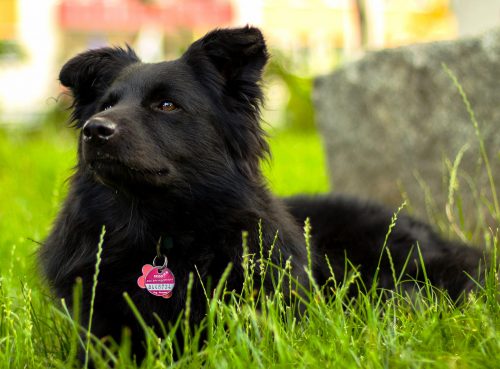As a dog owner, the last thing you ever want to see is your dog suffering. In the case of folliculitis, a characteristically itchy skin ailment that can leave your dog miserable, the disorder can stem from a variety of causes; therefore, the symptoms and treatments may vary.
A condition that affects that hair follicles, folliculitis is not only irritating to your pooch, but may also be indicative of underlying health issues. Although it is a very common skin condition in dogs, it’s not always easy to get rid of without the professional assistance of your veterinarian.
This article will explore the different signs of canine folliculitis, as well as ways to treat and cure your four-legged friend from this specific type of canine skin infection.
Symptoms of Folliculitis in Dogs

From bumps, pustules and scaly skin to excessive shedding, your dog’s folliculitis is the result of a hair follicle infection. Typically, these infections are caused by bacteria or yeast invading the hair follicle; however, it can also be a sign of a skin disorder (such as scabies or mange), or in more serious cases, a compromised immune system.
Symptoms of canine folliculitis are typically found in specific areas of the body, primarily the armpits, abdominal, and groin regions. Depending on the severity of your pup’s condition as well as the length of his hair (i.e., a long or short-haired breed), you may note the following telltale signs of folliculitis in dogs:
General Symptoms
Some of the most obvious signs of folliculitis are seen beneath your dog’s coat, including scales and crustiness of the skin, as well as small pimples, lesions and bumps. These symptoms may be seen in patches in a particular area or spread over large regions of the skin.
In nearly every case of folliculitis, your dog will be very itchy, and in some cases, you may notice hair loss. He may scratch, bite or lick the affected area, which will only make it worse; therefore, it’s important to see your vet at the onset in order to prevent further infection.
- Short-Haired Breeds: In the case of short-haired breeds, you may notice clumping of the hair on the surface of the coat.
- Long-Haired Breeds: For long-haired breeds, symptoms of folliculitis may be more difficult to spot with the naked eye; you may notice signs such as scaly skin, a dull coat, or excessive shedding.
- Mild Folliculitis: In instances of mild folliculitis, you will note small pustules with a hair shaft growing through the pimple; there are often rings or scales around the affected areas.
- Severe Folliculitis: In the event of severe follicle infections, large boil-like pustules can be seen on the skin. You may also notice discharge, crusting, and accompanying signs of skin infection and irritation.
- Breed-Specific Folliculitis: Certain breeds are more prone to folliculitis than others. For example, Miniature Schnauzers sometimes develop a form of the condition known as Schnauzer Comedo Syndrome, which is marked by blackhead formations on the length of the dog’s back.
If you notice one or more of these signs, be sure to get the assistance of your veterinarian as soon as possible. Even though folliculitis is a relatively common skin conditions in dogs, it can be detrimental if left untreated.
With proper treatment (including specially-formulated dog shampoos and medications), you will not only provide relief to your dog’s persistent itch, but help prevent harmful skin infections from spreading or worsening.

What to Expect at The Vet
At the vet’s office, your pooch will have his coat and skin examined carefully, including swabs and/or skin and hair samples to check for the presence of staphylococcal bacteria and ascertain if he’s suffering from another canine skin condition or an underlying health disorder or disease.
Your vet may also run additional tests, including fungal cultures, bacterial cultures, and other lab work to determine the root cause of the folliculitis.
If your dog’s condition is chronic or unresponsive to a prescribed treatment, your vet may continue to run tests until an appropriate and effective method of therapy is found. There are a number of different factors that can impact your pet’s treatment, including preexisting health problems, his breed, type of hair, disposition, and whether he lives indoors or outside.
Once your veterinarian weighs all of these factors into the equation, he can tailor a course of therapy suitable to your dog’s specific needs.
What Causes Canine Folliculitis?
Because folliculitis can be caused by several different factors, it’s essential to get to the root of the problem in order to properly treat and cure your pet. This section will address the main causes that lead to canine folliculitis.
Bacterial Infections
In most instances, bacterial infection is the most common culprit associated with this uncomfortable skin condition. In fact, folliculitis is actually a secondary symptom resulting from bacterial pyoderma (bacterial skin infection), which can cause a host of different symptoms and skin conditions, including canine folliculitis.
In the case where a dog may have preexisting skin conditions (such as mange, seborrhea or scabies), staphylococcal bacterial infections may set in, causing further harm to your dog’s skin and coat. This form of bacteria is easily spread by fleas, mites, and other parasites.

Since staphylococci can be transmitted between dogs and humans, it’s essential to wear disposable gloves when caring for your dog in the event that he’s been diagnosed with a staph infection. In addition to covering any exposed skin, be sure to wash your hands and forearms carefully after shampooing or administering topical treatments (such as medicated ointments) to prevent transmission and reoccurrence.
It’s also important to wash your dog’s bedding, blankets, and any towels you’ve in hot water with laundry detergent. Be certain to throw away cotton balls, swabs, or any other items used in administering your dog’s medicine right away, and follow your dog’s progress carefully throughout his course of treatment.
If you notice that he’s still scratching, licking, or biting the affected areas, call your vet immediately, as this behavior will only worsen the condition and possibly lead to spreading it to other areas of his body.
Fungal Folliculitis
Another cause of folliculitis in your dog may be linked to fungal agents. One of the most common forms of hair follicle infections is dermatophytosis (ringworm). Although it is frequently seen in puppies, adult dogs are also susceptible if they are exposed to this highly-contagious organism.
Symptoms of ringworm in dogs are marked by an accumulation of surface skin cells (scales), lesions, reddened and inflamed skin (erythema), darkened skin at the site of the infection (hyperpigmentation), itchiness, canine hair loss (alopecia) which may be circular or patchy, and poor coat.
Despite its name, ringworm is not really caused by a worm but a fungus; the terminology ‘ringworm’ refers to the ring-like patches that can form anywhere on the body, but are most frequently found on the dog’s head, paws, forelegs, and ears. Because pets can transmit ringworm to their owners (and vice-versa), it’s important to get your dog to the vet right away if you believe he has ringworm.
Demodectic Mange
Since puppies have an immature immune system and can’t fight off mites as a result, they are more prone to mange (technically known as demodectic mange or Demodex canis), which can lead to folliculitis.
In some rare instances, adult dogs can develop folliculitis from mange; however, it’s usually indicative of an underlying issue with their immune system or overall health.

Additional Causes of Folliculitis in Dogs
Other causes of folliculitis include hormonal imbalances, skin injuries, excessive grooming, temperament, immune deficiencies, hypersensitivity, and allergies in dogs, among others. There are certain breeds (such as Boxers, Standard Poodles, Cocker Spaniels, Chinese Shar Peis, English Bulldogs, Doberman Pinschers, Labrador Retrievers, and Pit Bull Terriers) that are more prone to skin allergies; however, any dog can develop them over the course of time.
Therefore, it’s important to pay close attention to your dog’s routine and his reaction to different environmental factors, as well as his diet and overall health. If you can identify and eliminate any known allergens along with the assistance of your vet, you can help to prevent reoccurring health problems associated with bacterial infections and eliminate your dog’s folliculitis.
Healing & Treatment: How to Care for Your Dog’s Folliculitis
As mentioned throughout this article, you’ll need a professional diagnosis from your vet in order to determine an appropriate course of treatment for your dog’s folliculitis. In the case of localized infections (i.e., symptoms only appearing on one or two areas of the body), your vet will likely prescribe topical therapy in the form of a medicated ointment or gel.
In the case of more severe infections, your vet may advise twice-daily bathing with a specially-formulated shampoo, as well as antibiotics or other oral medications to heal your pet from the inside out. Additionally, it is advised to keep your dog’s hair trimmed down to allow the medicine to treat the pustules while giving the skin a chance to breath and heal properly; if you are reluctant to clip your dog, seek the assistance of a professional groomer.
Below, a list of traditional treatments you can expect when caring for dog with folliculitis:

Addressing The Underlying Causes: In order to completely eliminate the presence of canine folliculitis, it’s essential to identify the source of your dog’s ailment. With the proper diagnosis from your vet, you can formulate a course of treatment to ensure that his condition isn’t reoccurring. Because there are a variety of causes for folliculitis, treatments may vary; therefore, it’s always advised to seek the professional advice of a licensed veterinarian.
Antimicrobial Shampoos: Once your dog has been diagnosed with folliculitis by your vet, he may prescribe a medicated shampoo to help expedite the healing process. Regular bathing with medicated dog shampoo will not only assist in clearing up the existing infection, but also rid your dog of other microorganism and debris on the skin that act as a breeding ground for other possible infections.
Be sure to follow your vet’s instructions carefully, or as indicated on the shampoo packaging, and repeat the treatment until your dog’s condition has completely cleared up.
Antibacterial Treatments: In addition to medicated shampoos, your vet may also suggest the benefits of antibacterial treatments, which come in a variety of topical forms, including gels, sprays, lotions and ointments.
As is the case of any therapy, follow your vet’s instructions carefully regarding the frequency of application and duration of treatment. An Elizabethan collar (cone) may be needed to prevent your pooch from licking off the topical treatment.




